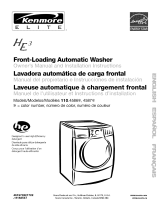
12
glow green. Selectable options will glow amber. If an option
or modifier is unavailable with a selected cycle, the light will
not illuminate. The display shows the estimated time
remaining. The preset settings provide the recommended
fabric care for the selected cycle. See “Cycles.”
5. Select the desired Options. Not all options are available with
all cycles. See “Options.”
6. Select the desired modifiers such as Water Temp, Spin Speed
and Soil Level. Not all modifiers are available with all cycles
and options. See “Modifiers.”
7. If desired, select the CYCLE SIGNAL. The signal is helpful
when you are washing items that should be removed from the
washer as soon as it stops. Select Loud, Soft or Off.
8. If desired, select the BUTTON SOUND. This feature makes a
sound each time a button is pressed. Select Loud, Soft or Off.
9. Select and hold START for approximately 1 second.
■ If you do not select START within 5 minutes of choosing a
cycle, the washer automatically shuts off.
■
When the wash cycle is complete, the DONE status light
glows, the door unlocks, and the wash load can be removed
from the washer. The washer powers down automatically
60 minutes after the cycle is complete and the DONE light
goes off. To power down the washer manually after the wash
cycle is complete, select PAUSE/CANCEL once.
10. To use the same cycle again, press POWER first, then select
START.
11. To begin the wash cycle later
Select DELAY WASH until the desired delay time (in hours)
shows in the Estimated Time Remaining display. Select
START. The countdown to the wash cycle will show in the
display window.
IMPORTANT: When delaying a cycle, use only powdered
detergents in the main wash compartment since liquid
detergents may seep out of the compartment during Delay
Wash, before the wash cycle begins.
Using the Dispenser
Your new washer has a dispenser drawer with four separate
compartments for your laundry products—two are for detergent,
one is for liquid chlorine bleach, and one is for liquid fabric softener.
Laundry products are diluted and dispensed automatically at the
proper time during the wash cycle, making it unnecessary for you
to return to the washer during the cycle to add them.
It is normal for small amounts of water to remain in the
dispensers when the wash cycle is complete.
Do not put laundry products directly into the wash tub. Always
use the proper dispensers when adding laundry products.
Choosing the Right Detergent
Use only High Efficiency detergents. The package for this type of
detergent will be marked “HE” or “High Efficiency.” This wash
system, along with less water, will create too much sudsing with a
regular non-HE detergent. Using regular detergent will likely result in
washer errors, longer cycle times and reduced rinsing performance.
It may also result in component failures and noticeable mold or
mildew. HE detergents are made to produce the right amount of
suds for the best performance. Follow the manufacturer's
instructions to determine the amount of detergent to use.
To fill dispenser compartments
1. Pull out the dispenser drawer.
2. Add the desired laundry product to the proper compartment.
3. Push in the dispenser drawer slowly and completely (to avoid
a spill).
Prewash detergent compartment
(Letter B in Dispenser Illustration)
Add detergent to this compartment when using the Prewash
option or Presoak. Liquid or powdered detergent may be used in
this compartment. The detergent will automatically be dispensed
during Prewash if the Prewash option is selected or during the
soak time if Presoak is selected.
■ Using High Efficiency (HE) detergent, add ¹⁄₃ the
recommended amount to the Prewash compartment and
²⁄₃ the recommended amount to the Main Wash
compartment.
Main Wash detergent compartment
(Letters A & C in Dispenser Illustration)
Add liquid or powdered HE detergent to this compartment for
your main wash cycle. The detergent type selector (A) must
always be in the correct position for the detergent type used.
Slide the detergent type selector to the correct position.
IMPORTANT: If you are using the Prewash, Presoak or Delay
Wash option, powdered detergent must be used in the Main
Wash compartment, since liquid detergents may seep out of the
Main Wash compartment before the main wash begins.
■ Use the detergent manufacturer's recommended amount for
load size.
■ Liquid or powdered color-safe bleach may be added to the
Main Wash compartment along with the same type of
detergent, liquid or powdered.
Use only HE High Efficiency detergent.
Dispenser
A. Detergent type selector
B. Prewash detergent compartment
C. Main Wash detergent compartment
D. Dispenser release lever
E. Chlorine bleach compartment
F. Fabric softener compartment
A
B
C
E
F




















